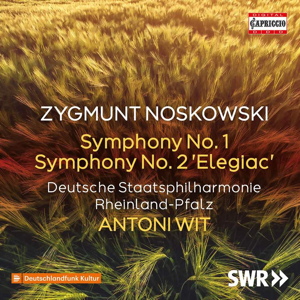
Zygmunt Noskowski (1846-1909)
Symphony No 1 in A major (1874-1875)
Symphony No 2 in C minor ‘Elegiac’ (1875-1879)
Deutsche Staatsphilharmonie Rheinland-Pfalz / Antoni Wit
rec. 2022, Philharmonie, Ludwigshafen, Germany
Capriccio C5509 [80]
Zygmunt Noskowski may be best remembered as Poland’s first exponent of the form we know as the symphonic poem. The first piece of his that I encountered years ago was a symphonic poem called The Steppe, played by Polish NSO Warsaw under Witold Rowicki on now long-deleted Olympia OCD389. In it, he finds drama and atmosphere in a very beguiling way.
It is a good idea to start with the 1st Symphony in the light-headed key of A major, placed second on the disc. It was the composer’s graduation exercise which got its first hearing in Warsaw. The substantial piece, a little over forty minutes, was certainly no mean achievement. The opening Allegro molto, which seems a little too steady in this performance, is melodious in a mid-period Dvořákian sense, elegant and lightly but colourfully orchestrated. Movement two is a memorable Adagio cantabile, lyrical and thoughtful. The ensuing Scherzo marked Vivace is, I think, in F sharp minor. It is mostly fleet of foot with some delicate woodwind writing but also has what I would call an aggressive streak. The Trio section is more legato but with beautifully shaped melodies shared between the orchestral sections. I find the rather Schumannesque finale less successful; how often do we say that? It is marked Allegro con fuoco, but I feel that Antoni Wit does not capture the fiery nature the composer presumably imagined. In fairness, the second subject is gently elegiac. In the lengthy development section, the textures become contrapuntal, and reach a fine climax before retracting into quieter, more reflective passages. The material, not all that memorable, appears overworked, especially in the coda. All in all, however, this is an enjoyable work and has much to commend time spent in paying it full attention.
Perhaps Noskowski had misgivings about aspects of the 1st Symphony, since he immediately set about starting a 2nd Symphony. That took four years until he was satisfied. The work of just over thirty-five minutes is entitled ‘Elegiac’. That seems appropriate, particularly as regards the serious and brooding key of C minor. Indeed, the opening is quiet and grave before it develops into a dramatic sonata-form movement, the longest of the symphony. It has a subtitle of ‘The Nation in Bondage’; Poland was under Russian control then. The powerful and lyrical Dvořákian Scherzo with, I think, two trios is subtitled ‘Hope and Call to Arms’. Movement three, subtitled ‘Elegia’ and ‘Elegy on the Fallen Heroes’, is the emotional heart of the work. Jens F. Laurson’s useful booklet essay – thanks! – mentions Polish traditional melodies and quite correctly describes the movement as ‘passionately lyrical’. The sense of drama and foreboding, which ends this movement, continues into the finale entitled ‘Per aspera ad astra’ (through adversity to the stars). That emphasises the Nationalistic element, crucial to understanding this symphony and its glorious ending. It has even been said that there are references to a Mazurka named after a Polish general, which later become the Polish national anthem. Noskowski died 19 years before his country regained independence.
The performances are generally strong and in style. The recording is vivid and clear. The works have weaknesses, but there is much that is appealing and worth studying. Their appearance and easy availability outside Poland should be of interest to all with a bent for discovery.
Gary Higginson
Previous review: Rob Barnett (August 2023)
Help us financially by purchasing from





















